Bio Plant Diversity
1/112
There's no tags or description
Looks like no tags are added yet.
Name | Mastery | Learn | Test | Matching | Spaced |
|---|
No study sessions yet.
113 Terms
Synapomorphy of Plantae
Believed it has occurred ONCE in evolutionary history (with one exception for a single species in Rhizaria) giving rise to lineage of plants
Cyanobacterium ingested and escapes digestion by vacuoles
Horizontal gene transfer incorporates some cyanobacteria genes in nuclear genome
Organisms OUTSIDE the plant lineage that have chloroplasts gained them via endosymbiosis of an ancestral “plant” -> secondary of even tertiary endosymbiosis
Endosymbiosis was a long time ago - DNA has had ?
a lot of time to evolve and change
Primary Endosymbiosis
We define plants as beginning with priamry endosymbiosis - All plantae have the primary chloroplast
Plantae are defined as the Archaeplastida supergroup
Glaucophytes
Unicellular organisms
May resemble some of the earliest plants
Sister group to all other Archaeplastida because of
Retains residual peptidoglycan in chloroplast membranes
Vegetative cells in mother cell wall with extra-large chloroplasts
Plants
Aquatic and land plants
Algae
aquatic photosynthetic eukaryotes
Not a phylogenetically meaningful term
Some are plants, some are protists (brown algae..), some are prokaryotes (cyanobacteria/blue-green algae)
Phycology
the study of algae
Red Algae
Contain a red accessory photosynthetic pigment
Phycoerythrin
Do not always necessarily appear red
Most multicellular and marine -> attach to substrate via holdfast
(like brown algae)
Absence on land may relate to large genome reduction
Chlorophyta
Chlorophytes have a wide diversity of forms
Largest group of Green Algae
Unicellular to multicellular organisms
Volvox - unicellular but forms large colonies
Ulva ridida grows into thin, membranous sheaths a few cm across
Coleochaetophytes
One of the closest relatives to land plants
Multicellular
Retain eggs in the parental organism (like land plants) and have cells connected by plasmodesmata
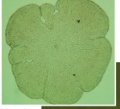
Stoneworts
Closest relative of land plants
Multicellular
Retain eggs in the parental organism (like land plants) and have cells connected by plasmodesmata
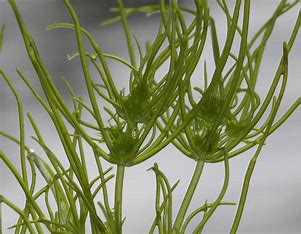
First land plants appeared on land …
400-500 mya
How do environmental conditions on land differ from aquatic environments (think of different challenges that they had)
How much rain they get
What temperatures they can survive
How are gamates going to connect to each other now that theyre on land? (stresser)
Protection needed for embryos from drying out
Adaptations of Land Plants
Protection from desiccation (water loss)
Secrete their waxy membrane (cuticle) - Cells cannot lose the water directly from the cell
Stromata (pores for gas exchange)
Protection of reproductive structures
Gametangia (they are multicellular, they are organs, enclose the gametes)
Embryos in protected structure
Thick spore walls (desiccation and decay)
Protection from UV Radiation
Leaf pigments - to help with increasing or decreasing the radiation
Support to counteract gravity
Acquiring and transporting nutrients
Mycorrhizae
Vascular tissue
Alteration of Generations
Multicellular diploid and haploid stages alternate
This includes ALL Land plants
Gametes - sperm and egg - haploid produces a zygote ->diploid
The zygote develops then into a diploid sporophyte
The sporophyte produces haploid spores by meiosis in a special process
The spores germinate and divide to form the haploid gametophyte
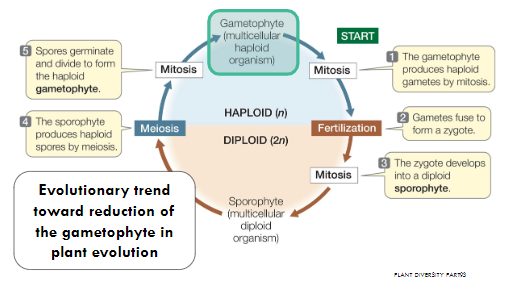
Gametophyte
Multicellualr haploid organism
Sporophyte
Multicellular diploid organism
Non-vascular Land Plants
Mosses, Hornworts and Liverworts
Non Vascular Land Plants qualities
They don't have any inner transport system - they must move via diffusion or capillary action - this results in them being short
Lack true leaves, stems, and roots
Analogous structures are present
Thin cuticle, or none
Thus moist habitats only
Mycorrhizae
symbiotic association between a fungus and a plant
Arbuscular mycorrhizae-like fossils
Some nonvascular plants live on bare rock
Arbuscular mycorrhizal mutualism
Helped with absorption of water and minerals from the first soils
Life Cycle of a Non-Vascular Plant
Dominant generation
Fertilization requires water
Gametophyte - what we see
Archegonia and Anthoridium - Create the gamates
Diploid - when the sperm and the egg meet and begin the Sporophyte
Sporophytes are typically not photosynthetic
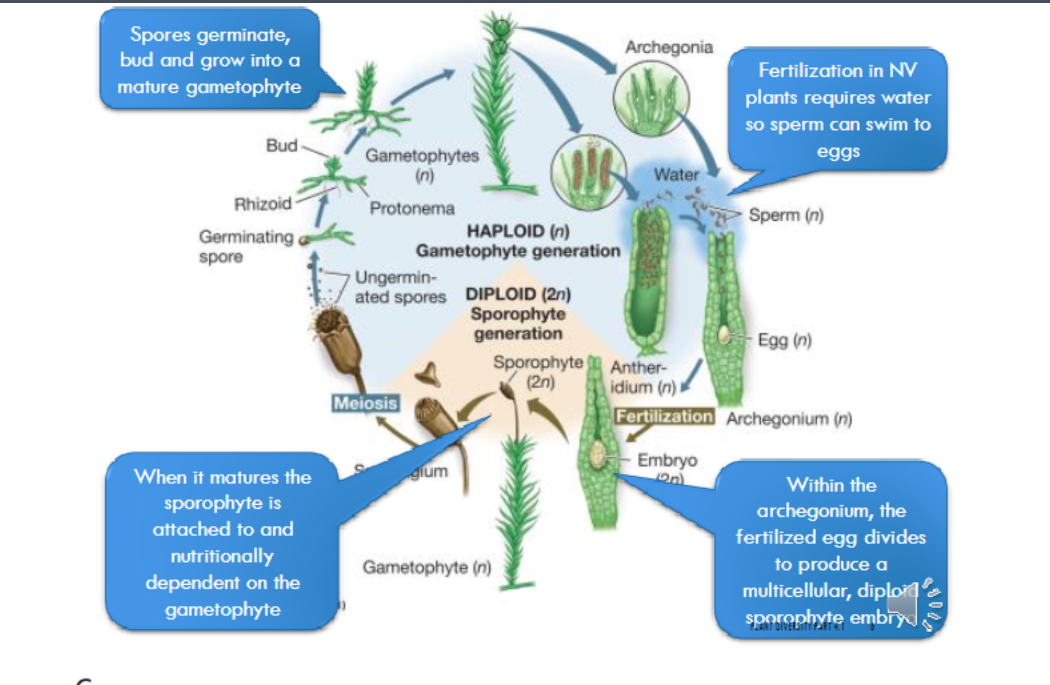
Liverworts
Cuticle but no stomata
waxy membrane (cuticle) - Cells cannot lose the water directly from the cell
Stromata - gas vents
Highly reduced sporophyte
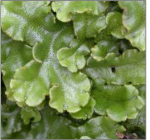
Mosses
Mosses have stamata (water and gas exchange)
Ephemeral (meaning not always there) sporophyte
Rhizoids (not true roots) help anchor to ground and take the function of absorbing
Archegonia
a multicellular structure or organ of the gametophyte phase of certain plants, producing and containing the ovum or female gamete
Where the egg sits waiting for a sperm

Hornworts
Gametophytes are flat plates of cells
Stalk-less sporophyte, basal region with indefinite cell division
Sporophyte always green
Internal cavities with N-fixing cyanobacteria
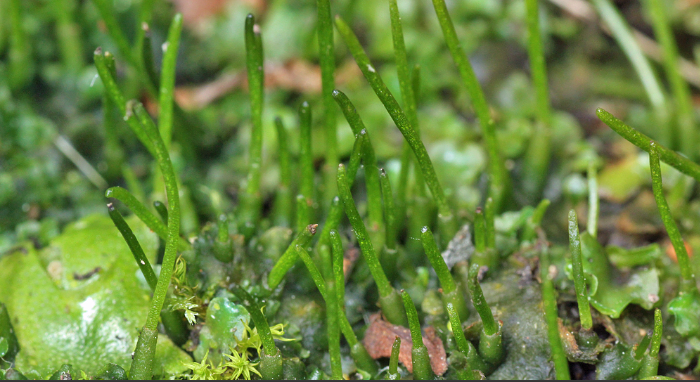
All of the other plants other than mosses, hornworts and liverworts have…
Vascular Tissue (Tracheophytes)
Vascular tissue allows plants to:
Have a greater division of labor (organs)
Roots - specialized to anchor plants and to obtain water/nutrients
Stems (Shoots) - specialized for light competition (suport), connect leaves and roots
Leaves - specialized to photosynthesize
Lignin in vascular tissue helps plants grow taller
Lignin in cell walls, smaller cell in between the cells called fibers
Lignin
Helps plants grow taller - In cell walls, smaller cell in between the cells called fibers
Key Synapomorphy of Vascular Plants:
Vascular system made up of xylem and phloem
What advantage does vascular plants have over non-vascular plants?
Ability to transport water and food throughout their bodies allowed them to spread to new environements and diversify rapidly
Why is water necessary for the life cycle of nonvascular and early vascular plants?
For non-vascular, the sperm has the flagette and needs to swim in order to reach the egg.
For vascular, they needed water to reproduce, grow, and disperse
xylem
Transports water and minerals from soils up to the rest of the plant
Lignin provides structural support
Phloem
Transports sugars from photosynthesis throughout the plant
Earliest diverging group of vascular plants
Rhyniophytes - Branching nutritionally independent (photosynthetic) sporophyte
Had central column of xylem but tracheids differ from later-diverging groups
Increased spore production
Lacked true leaves and roots
Critical adaptions for Tracheids (two taper ends)
Transportation of water and minerals
Rigid structural support (lingin)
Allowed plants to grow taller
Competition for light
Aids in spore dispersal
Parents are going to compete with the children
Lycophytes
First extant group to diverge from vascular plants (400 MYA), relatively few surviving species
Possess microphylls & dichotomous branching roots and stems

Microphylls
a type of plant leaf with one single, unbranched leaf vein
Thought to have evolved from sterile sporangia
Sporangia
an enclosure in which spores are formed
Pteridophytes
Ferns and fern allies
Have a different type of leaf
Possess megaphylls - Overtopping growth & branching roots
Megaphylls
Overtopping growth & branching roots - give more light capture for the plant to use and grow
Lifecycle of Seedless Vascular Plants
(Ferns still require habitats that have a little bit of moisture because of the sperm that have the flagellates that need to swim in order to reach the egg)
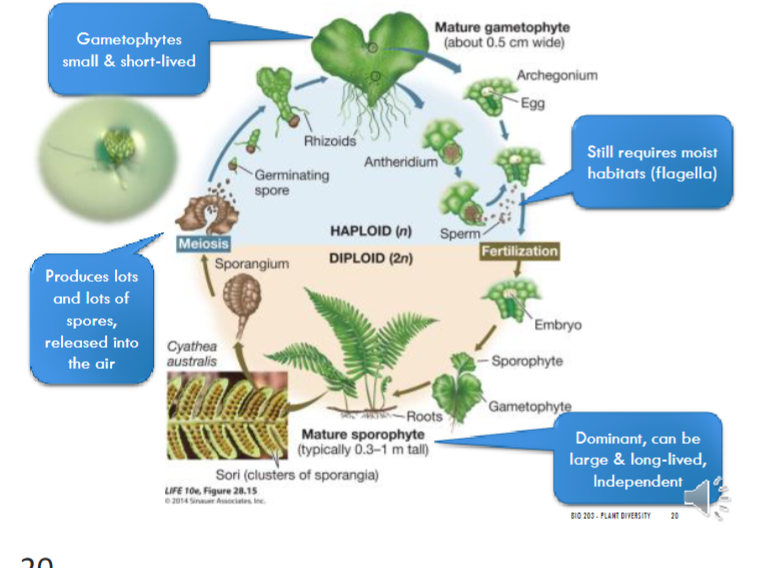
Trend: Reduction of the Gametophyte
Most gametophytes nourish sporophytes
There is a size difference in the two sporophytes, but each is nutritionally independent in ferns
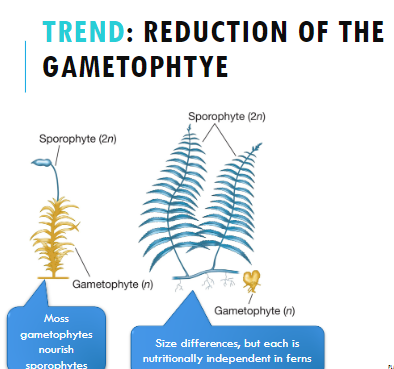
Where are the egg and sperm produced in seedless vascular plants vs seed plants?
Seedless:
Egg: Archegonium
Sperm: Antheridium
Seeds: male and female gametophytes, sperm and egg, respectively
The most ancient vascular plants had
only one spore (one gametophyte)
Homospory
The most ancient vascular plants had only one spore - Homospory
One type of gametophyte that has male and female reproductive organs
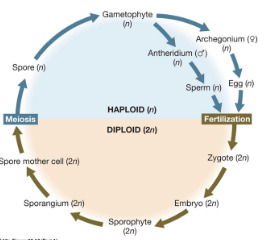
Heterospory
Multiple types of spore - Megaspore (Female) and Microspore (Male)
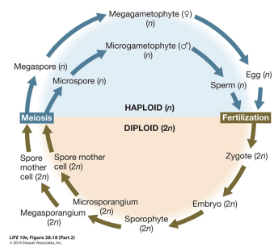
Megagametophytes
Produce eggs = OVULE
Microgametophytes
Produce sperm = POLLEN
Fertilized ovules become
Seeds
Gymnosperms comes from Greed for “naked seeds”
Only angiosperms enclosed seeds in a ovary, which becomes a fruit
Advantages Seed Plants have over non-seed plants
Retain spores rather than use for dispersal
Fermentation conditions are always ideal
Nourishment for growing gametophytes
Pollen as a “water-free” sperm movement mechanism -> gametes themselves protected
Live in arid environments
Coincide with the cooling and the drying of the air - less moisture in the air, more able to live compared to the non-seed plants
Seeds are mobile food sources for growing embryo/ seedling and allow dispersal
Three Major Lineages in Gymnosperm clade
Cycads, Ginkgo, and both Conifers and Gnetales
Cycads
Earliest diverging group (300 mya) of ~300 species
Many endangered, trade is regulated
Some cycads have “coralloid” roots which are symbiosis with cyanobacteria for N fixation from atmosphere
Cycad cones bear either ovules or pollen and emit odors to attract beetles/weevils when mature (convergent evolution with angiosperms)
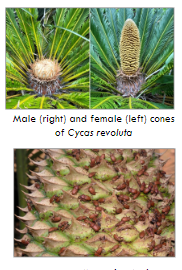
Ginkgo
Single relict species, popular street tree
Individuals are either “male” or female”
Sex chromosomes system of X and Y similar to humans
Garden plantings usually choose “male” trees
The seeds are quite pungent (why we have males)
Pollen is much worse for allergies
Without “male” trees, the female trees wouldn’t set seeds
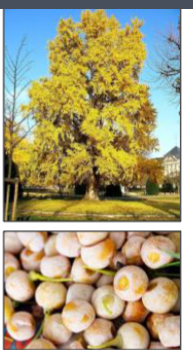
Conifers
Conifers are the most abundant group of gymnosperms - named for their seed cones (pinecones)
Most are evergreen although some do lose their leaves (tamarack, bald cypress)
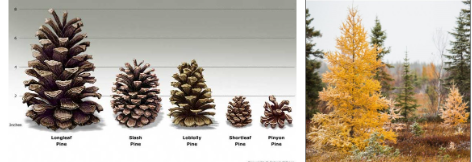
Gnetales
Gnetales have three genera:
Ephedra (Medicinal uses) (Mormon Tea)
Welwitschia (Only grows two leaves) (Grows only in the Namib desert)
Gnetum
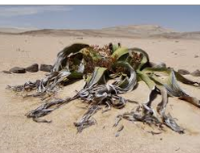
Gymnosperm Reproduction - Conifers
Conifer spores are retained in cones
Two spore types are produced in sporangia located in two different cone types
Two different cones produce different spores
Microsporangia
Microstobili (2n) contain microsporangia in which a mother cell undergoes meiosis producing microspores (n) what develop into a multiceullar pollen grains, a strongly
reduced male gametophyte
Pollen grains
Contain Sporopollenin
Most chemically resistant biological compound known
Very difficult to decompose
Most common way to look at fossils
Found in pollen and the spores of seedless vascular plants (ferns, etc.)
Female Pinecone = Megastrobilus
Contains megagametophyte at maturity
And eventually the developing seed with fertilized embryo
Fertilization is Internal for Pine Cones
No Water Required (although cycad/ginkgo sperm still have flagella)
Allows plants to grow in a LOT more places/habitats
Internal fertilization
Pollenation
What method do conifers use for pollination?
Wind
All conifers are non-flowering
Wind moves pollen from male to female cones
Need to make a lot of pollen
Gymnosperm Seeds
Shed in autumn, one year after fertilization
Hold some food reserves (female gametophyte tissue)
Competitive edge for seedlings
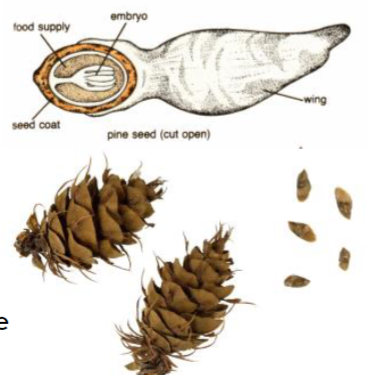
Integument
After fertilization, it develops into a seed coat
Four major advantages of Gymnosperms
The gametophyte (n) is now dependent upon the sporophyte (2n) - spores retained
The gametophytes are extremely reduced, and the male gametophyte serves as the dispersal agent for sperm
Internal fertilization via pollen delivery
Large food reserve for their offspring (seed)
Monocot vs Dicots
Monocots have only one cotyledon while dicots have two
Mega/Microsporangia
Megasporangia - Female sporangia that generate megasporocytes, which in turn generage megaspores
Microsporangia - Male sporangia that generate microsporocytes, which in turn generate microspores
Angiosperm Flowers
Able to use animal-facilitated pollination
Increases the odds of successful pollination
Lower relative resource investment for pollen
Sporophyll
A (modified) leaf that has sporangia
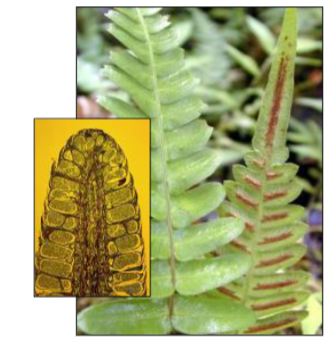
Sepals
Looks most like leaves, for protection
Carpels
Derived from megasporophylls and eventually become fruits
Whole plants can be monecious or dioecious
Monecious = flowers are imperfect, but both female and male flowers appear on a plant
Corn
Dioecious = complete separation of imperfect flowers
Individual plants will only have one type of flower
One will develop fruit and one will develop …?
Can also refer to gynosperm (no flowers)
Flowers can be perfect or imperfect
Perfect = functional mega and microsporangia -> both gametophytes within one flower
Imperfect = one is absent or non-functiona
Angiosperms reproduction is…
heterosporous
Stamen
The pollen-producing reproducive organ of the flower
Derived from microsporophylls
Inside an anther is a captivity called the…
pollen sac
Cotyledons (Seed Leaves)
Allows seed leaves to nourish the plant before PS is capable of supporting seedling
anther
The part of the stamen that produces and contains pollen in flowering plants
The pollen sac contains…
microspore “mother cells” that undergo meiosis once -> four haploid microspores
Each microspore divides ONCE by mitosis
Angiosperm microgametophyte has two haploid cells
Generative cell -> will form 2 sperm upon germination
Tube cell -> generates the pollen tube
A single style can have many ovules
Have own pollen tube that delivers a unique sperm into that egg
Angiosperm megametophyte
The ovary contains one or more ovules
Ovules are not enclosed in any tissues
Ovule = macrospore “mother cell” within the protective integument - ONLY ONE IN EACH
Mother cell produces four megaspores via one meiosis event
Only ONE of the megaspores survive. Others die via apoptosis
Ovule
macrospore “mother cell” within the protective integument
The surviving haploid megaspore (the champion of the four megaspores produced from megaspore) divides…
by mitosis THREE times
Megagametophyte (embryo sac) has eight nuclei in seven cells
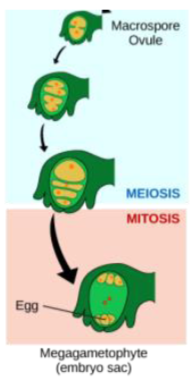
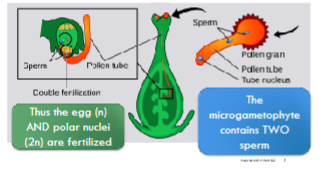
Double Fertilization
The microgametophyte contains TWO sperm
One sperm fertilizes the egg
One sperm fertilizes the POLAR NUCLEI
Forms 3n endosperm
Only in Angiosperms
Food source for embryo - remaining gametophyte tissue
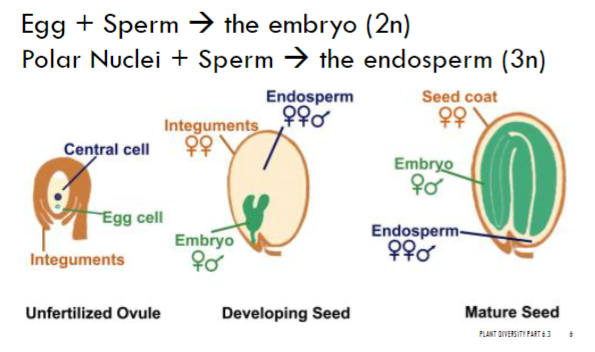
Angiosperm are the most successful group of the modern era due to:
Animal pollination
More efficient seed production & nutrition
Fruits
New conducting cell type in xylem tissue (cover later)
Shoot system
stem and leaves
Root system
just roots
What are the tissues that compose plant organs?
All parts of the plant body are made up of three major tissue systems
Ground - center
Dermal - epidermis
Vascular
What affects development in plants?
Development in a multicellular organism is governed by four processes:
Determination
Certain cells are going to be part of something, like heart cell (stem cell can be anything)
Differentiation
Acquisition of the cell type and specialization
Morphogenesis
The differentiated cells are organized into their specific places
Growth
Expansion of the cells
What affects development in plants?
These occur in animals and plants, but plants have unique properties that affect development
Apical Meristems
Totipotency
Vacuoles
Cell Walls
Apical meristems
Meristems = regions of undifferentiated cells
Location of cell division
Tips of roots and shoots
Plants grow throughout their lives
Totipotency
- ability for a cell to become anything
Describes cells that can differentiate into any type of cell in the body
In animals, only embryonic stem cells are normally totipotent
In plants, some differentiated plant cells can become totipotent
Rapid repair of damage from herbivores, the environment, etc.
Vacuoles
May be up to 90% of the plant cells volume
STORAGE
Contains water with a high concentration of solutes (sugars from photosynthesis)
Osmosis
Water movies across a membrane from a high solute potential to low solute potential (more negative)
Turgor Pressure in plant and human cells
Hypertonic - water is moving out of the cell - dehydrated
Isotonic - equal movement of water into and out
Hypotonic - inflated cell - creating turgor in the cell walls - pressure
Cell Walls
Cell wall fixes cells in place, they cannot move as in animal development
Thus, plant morphogenesis is controlled by planes of cell division (which direction is the cell replicating)
Cells walls also affect expansion
Cell walls resist expansion -> they must grow for cells to expand
Proteins called expansins loosen the bonds between cellulose and other microfibrils in the walls
Primary vs. secondary cell walls
Only primary cell walls in growing plants
Secondary cell walls are too rigid to expand -> contain lignin
Too thick to have transport - will die soon